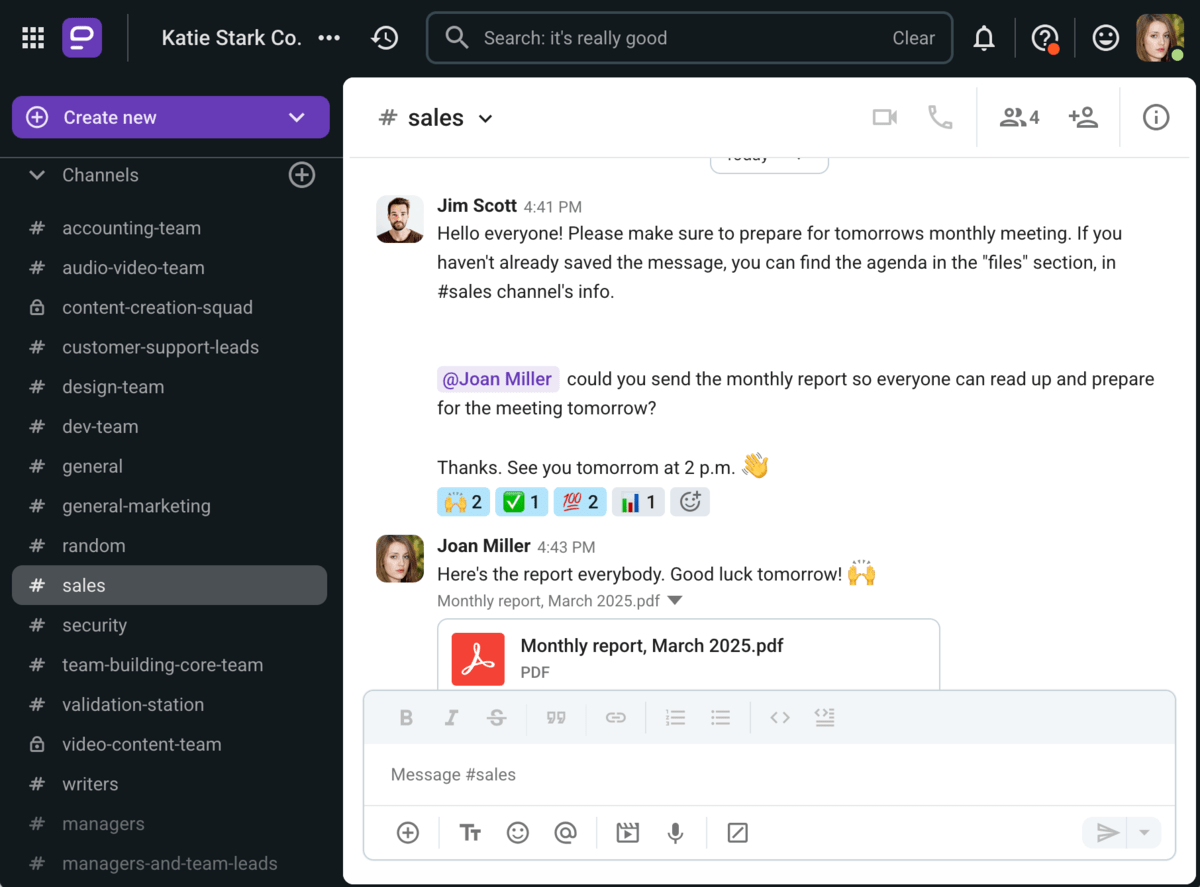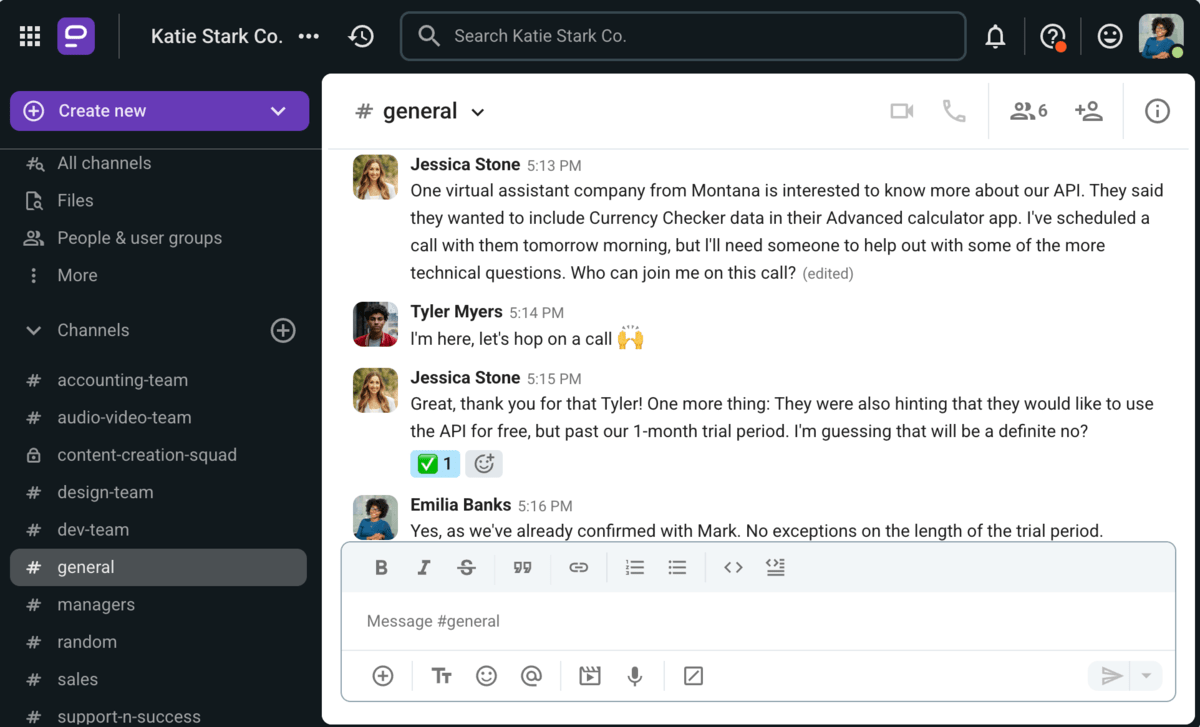La communication professionnelle est à la base de la réussite de toute organisation, quels que soient sa taille, son secteur d'activité ou son modèle d'entreprise.
En abordant les problèmes pertinents et en améliorant la communication au sein de votre équipe, vous pouvez vous attendre presque à de meilleurs résultats en termes de performance, d'image d'entreprise, de moral d'équipe et de profit.
Dans ce guide, nous aborderons tous les aspects de la communication professionnelle, y compris :
- La définition et des exemples de communication professionnelle efficace,
- L'importance d'une communication professionnelle efficace et les problèmes qu'elle résout,
- Les types et les méthodes de communication professionnelle,
- Les conseils et les techniques pour améliorer la communication professionnelle.
Nous allons analyser et vous aider à transformer la communication professionnelle au sein de votre équipe.

La communication professionnelle et les points clés
La communication professionnelle est l'échange d'informations entre deux ou plusieurs personnes à l'intérieur et à l'extérieur d'une organisation.
Les auteurs de Business Communication: Systems and Applications, Ricks and Gow, définissent la communication d'entreprise comme « un système qui affecte le changement au sein de l'organisation dans son ensemble ».
Les 5 éléments clés de la communication d'entreprise sont les suivants :
- L'expéditeur — ou la source, est la personne ou le groupe à l'origine de la communication (employé, directeur, clients, agences, fournisseurs, sous-traitants, etc.).
- L'information professionnelle — l'élément d'information que l'expéditeur souhaite communiquer à d'autres (message, mémo, email, document, rapport, etc.).
- Le canal — le moyen utilisé par l'expéditeur pour transmettre l'information (téléphone, email, lettre, message de chat, etc.).
- Le destinataire — ou l'audience, sont les destinataires de l'information commerciale.
- Le feedback — ou la réponse, désigne la réponse transmise par le destinataire du message. Le feedback fait partie intégrante du processus de communication professionnelle, car il détermine si l'information professionnelle (le message) a été envoyée et interprétée avec succès.
Qu'est-ce qui rend la communication professionnelle efficace ?
Une communication professionnelle efficace fait référence à tout type d'échange d'informations à l'intérieur et à l'extérieur d'une organisation, dans le but d'atteindre achieving les objectifs de l'entreprise.
L'objectif de la communication d'entreprise est de :
- Améliorer les processus internes,
- Atteindre les objectifs de l'organisation, et
- Minimiser les erreurs.
Une communication professionnelle efficace rassemble tous les processus, les flux de travail et les personnes d'une organisation en une unité cohérente et productive.
En plus d'affecter les processus organisationnels plus larges, une communication commerciale efficace est également essentielle pour :
- Rédiger des propositions et des plans,
- Conclure des accords,
- Avoir des réunions efficaces, et
- Améliorer les ventes.
Quels sont les types de communication professionnelle ?
Il existe quatre principaux types de communication professionnelle dans une organisation type :
- Communication interne ascendante — lorsqu'un employé de niveau inférieur entame une conversation avec son supérieur.
- Communication interne descendante — lorsqu'une personne d'un niveau hiérarchique supérieur entame une conversation avec un employé de niveau inférieur (communication directive, instructive et généralement plus immédiate).
- Communication interne latérale — interaction entre des individus ou des groupes appartenant au même niveau hiérarchique dans une organisation.
- Communication externe — communication avec des tiers extérieurs à l'organisation, tels que le grand public, les clients, les fournisseurs, les partenaires, les vendeurs, les consultants, etc.
La connaissance de ces 4 catégories peut vous aider à analyser les domaines dans lesquels votre communication sur le lieu de travail doit être améliorée.
Comment améliorer la communication dans les entreprises ?
Comme le confirment diverses enquêtes et études sur la communication l'amélioration de la communication dans l'entreprise apporte d'immenses bénéfices à vos opérations internes et externes.
Selon Statistiques sur la communication au travail, de Pumble, le coût d'une communication inefficace sur le lieu de travail se situe entre 10 000 et 55 000 dollars par employé et par an.
Alors, comment créer une bonne stratégie de communication dans votre organisation ?
Voici quelques-uns des conseils les plus efficaces pour améliorer la communication au sein de l'entreprise.
Conseil n°1 : Évaluez l'état actuel de votre communication professionnelle et fixez des objectifs
L'analyse de l'état actuel de votre communication professionnelle vous aidera à identifier les points faibles et les points à améliorer. Elle vous servira également de base pour fixer les bons objectifs pour votre future communication professionnelle.
Pour améliorer la communication, la première étape consiste à la comprendre. Si vous constatez que la communication peut être améliorée sur votre lieu de travail, vous devrez vous poser des questions telles que :
- À quel stade du processus de communication la mauvaise communication se produit-elle ?
- S'agit-il d'un problème de communication interne, externe, latérale, ascendante ou descendante ?
- De quelle manière une mauvaise communication entrave-t-elle les objectifs de votre entreprise ?
- Existe-t-il des étapes ou des procédures possibles qui peuvent être mises en œuvre pour éviter cela ?
- Quelle est la manière la plus simple d'aborder les problèmes de communication au sein de votre équipe ?
- Y a-t-il des changements majeurs à apporter pour que votre équipe fonctionne correctement ?
Une fois les problèmes identifiés, vous pouvez commencer à élaborer un plan qui s'attaque à ces points sensibles spécifiques. Dans ce cas, l'objectif pourrait inclure l'établissement de lignes directrices claires concernant le volume et la qualité de la communication interne, ainsi que des points d'action sur la manière de les mettre en pratique.
Conseil n°2 : Identifiez les groupes clés et analysez comment ils communiquent entre eux
Une fois que vous avez analysé les problèmes potentiels qui entravent la communication globale de votre entreprise il est temps de faire une évaluation plus approfondie de la façon dont les groupes principaux de votre organisation communiquent.
Cette étape peut vous aider à identifier des problèmes plus spécifiques et, ainsi, à fixer des objectifs et des plans d'action plus pertinents.
Pour commencer, essayez de définir d'abord les groupes clés dont les opérations dépendent d'une communication et d'un partage d'informations efficaces. Vous pouvez les catégoriser à différents niveaux, notamment :
- Groupes horizontaux — équipes, unités ou départements (par exemple, marketing, conception, ventes, finance, ressources humaines, etc.)
- Groupes verticaux — managers, gestionnaires, chefs d'équipe, membres d'équipe
- Groupes externes — clients, partenaires, fournisseurs, consultants, etc.
Une fois que vous avez identifié les groupes clés, analysez leur interaction en utilisant des paramètres pertinents tels que :
- Le feedback,
- Le reportage,
- La fréquence de communication,
- La communication de crise,
- Les conversations non pertinentes,
- Le réunions, etc.
Pour les groupes horizontaux, vous pouvez évaluer quelles personnes, équipes et groupes dépendent d'une communication régulière pour soutenir les opérations quotidiennes, hebdomadaires ou mensuelles.
En ce qui concerne la communication verticale, pensez à analyser la qualité et la fréquence du feedback, des rapports, du suivi des progrès et des approbations.
De même, la communication externe peut être analysée en fonction de la fréquence et de la qualité des échanges avec les clients et les partenaires.
Les informations obtenues grâce à cette analyse peuvent vous aider à déterminer le volume de communication optimal nécessaire pour mieux soutenir les différents processus et équipes. De plus, cela peut vous aider à prendre des décisions plus éclairées quant au choix des bons outils et canaux de communication.
Conseil n°3 : Définissez des méthodes de communication pertinentes
La communication peut être réalisée en utilisant diverses méthodes. Cependant, toutes ne sont pas nécessairement pertinentes pour chaque entreprise.
Les méthodes de communication commerciale courantes incluent :
- Les réunions en personne,
- Visioconférence,
- Les conférences téléphoniques et audio,
- La communication sur le web,
- La communication écrite via des fichiers partagés,
- Les enquêtes internes et externes,
- La gestion de la relation client.
Le choix dépend largement du type et de la taille de l'entreprise, ainsi que des objectifs spécifiques de communication commerciale que vous visez à atteindre.
Par exemple, si votre objectif est d'améliorer la communication et la collaboration entre les différents départements, vous pouvez définir une méthode basée sur le web comme méthode par défaut pour l'échange rapide d'informations, de fichiers et de retours entre les équipes.
En même temps, les méthodes de communication dépendent aussi largement de la taille et du modèle économique dans lesquels les organisations opèrent. Dans cette optique, une petite équipe travaillant au bureau opterait pour des réunions internes en personne, et utiliserait la messagerie sur le web pour la collaboration et la communication externe.
Cependant, une grande organisation entièrement à distance devrait s'appuyer sur la visioconférence comme alternative aux réunions en face à face, en plus de la collaboration asynchrone basée sur le web.
Organiser vos réunions avec Pumble
Conseil n°4 : Adoptez les bons outils
Il n'existe pas de solution universelle en matière de choix d'outils pour faciliter la communication d'entreprise. Il faut définir vos besoins uniques et les comparer aux outils disponibles pour trouver la solution qui correspond parfaitement à votre stratégie et à vos objectifs de communication.
Ceci étant dit, il existe plusieurs fonctionnalités généralement applicables à rechercher dans un outil de communication, quelle que soit la taille de votre entreprise, votre modèle de travail ou vos préférences uniques. Par exemple, les fonctionnalités universellement pertinentes sont :
- Une interface conviviale,
- Une sécurité maximale, et
- Des fonctionnalités permettant une collaboration productive.
Voici quelques règles à suivre lors du choix et de l'adoption des bons outils de communication pour votre entreprise :
- Utilisez une plateforme centralisée pour les emails et les calendriers afin de synchroniser automatiquement les disponibilités et de mieux gérer la communication et la collaboration au sein de votre organisation.
- Stockez les informations et documents vitaux dans le cloud avec une sauvegarde automatique pour éviter de perdre des données critiques.
- Définissez des règles de base pour avoir une voix, un ton et une étiquette de chat cohérents pour votre marque sur tous les canaux de communication. Cela évitera les malentendus et les conflits potentiels, et garantira que toutes les équipes appliquent les principes de la communication respectueuse sur le lieu de travail.
- Utilisez un seul outil de messagerie professionnelle à l'échelle de l'entreprise. Il est très facile de tomber dans le piège de la mauvaise communication lorsqu'un service utilise une application tandis que d'autres communiquent via une autre.
- Recherchez des outils multifonctionnels qui facilitent une collaboration rationalisée. Des fonctionnalités telles que le partage de fichiers, des options de messagerie polyvalentes, la disponibilité des membres, des notifications intelligentes et une navigation fluide offrent une expérience de communication et de collaboration plus efficace.

Partager les fichiers facilement avec Pumble
Conseil n°5 : Identifiez et cultivez les compétences pertinentes en communication d'entreprise
Selon les statistiques de Pumble sur la communication en milieu de travail, les entreprises qui investissent du temps et des ressources dans l'amélioration des compétences en communication de leurs employés sont susceptibles de connaître une augmentation de productivité allant jusqu'à 25 %.
Il est tout à fait compréhensible qu'une productivité et une performance accrues des employés mènent à une meilleure réussite globale de l'entreprise.
Voici les compétences pertinentes en communication d'entreprise à considérer :
- Compétences collaboratives — Créer un espace pour le développement des compétences collaboratives permet aux équipes de travailler ensemble plus efficacement et de découvrir des moyens plus efficients d'atteindre les objectifs organisationnels.
- Diplomatie — Des compétences diplomatiques bien développées permettent aux représentants commerciaux et aux professionnels du support client de mieux comprendre les perspectives et les besoins des clients, et ainsi de fournir de meilleures solutions et un meilleur soutien.
- Compétences en négociation — Indispensables à plusieurs autres activités commerciales, telles que la discussion des salaires ou des promotions, ou la communication avec les investisseurs.
- Compétences en présentation — Affectent de nombreuses activités et processus commerciaux, de la collaboration efficace à l'acquisition de clients et à la réalisation de ventes.
- Prise de parole en public — De la présentation de conférences à la prise de parole lors de conférences sectorielles, en passant par les allocutions devant des investisseurs ou des communautés, la plupart des professionnels sont amenés à s'engager dans une forme de prise de parole en public pour capter l'attention du public et créer un lien par la narration.
- Écoute active — Favorise de meilleures relations de travail et une collaboration plus productive, en plus d'être l'une des composantes clés de la négociation.
- Compétences en rédaction professionnelle — Maîtriser cette compétence commerciale peut vous aider à prévenir les malentendus, à améliorer la collaboration, à assurer une communication claire des tâches et à faciliter de meilleures relations de travail.
- Résolution de conflits — Ces compétences aident une équipe à sortir d'une crise et à résoudre les conflits ainsi que d'autres situations stressantes. Elles sont utiles aux managers et aux leaders, ainsi qu'aux employés de niveau inférieur, pour gérer les situations stressantes et trouver des solutions créatives aux problèmes rencontrés.
- Prise de décision — Essentielle pour atteindre les objectifs avec succès, tant au niveau individuel qu'organisationnel.
- Compétences en communication non verbale — Les professionnels qui maîtrisent la communication non verbale réussissent mieux à transmettre le bon message lors des conversations avec les clients, des réunions d'équipe ou des conférences sectorielles.
- Compétences en communication de feedback et d'apport — Ces compétences offrent des avantages substantiels en termes de performance et d'engagement organisationnels et elles sont également précieuses pour les employés à un niveau plus individuel car elles favorisent une progression de carrière plus rapide.
- Compétences en délégation — Aident les leaders à organiser efficacement la charge de travail et à attribuer stratégiquement les tâches pour une productivité maximale.
Conseil n°6 : Documentez et partagez vos processus de communication interne
Lorsque vous travaillez à mettre en place des pratiques de communication interne plus efficaces, les organisations doivent s'assurer que tout le monde a accès aux stratégies, procédures, ressources, outils et supports d'apprentissage.
Envisagez de documenter vos processus et supports de communication interne dans une base de connaissances partagée ou un QG numérique, et cela servira de liste de contrôle que les employés, nouveaux comme actuels, pourront consulter.
Enfin, partagez ce document via un email à l'échelle de l'entreprise ou épinglez-le dans un canal #general de votre application de messagerie d'équipe pour qu'il reste accessible et présent à l'esprit de toute l'organisation.

De quelles méthodes de communication professionnelle votre équipe a-t-elle besoin ?
Lorsqu'elles sont chargées de choisir les bonnes méthodes de communication pour leur équipe, les organisations doivent tenir compte de leurs besoins et de leurs circonstances uniques. Il n'existe pas de solution unique qui convienne à tous les modèles et tailles d'entreprise.
Ceci étant dit, il existe au moins une méthode de communication universellement applicable que la grande majorité des organisations trouveront très utile — la communication basée sur le web.
La communication basée sur le web peut être utilisée dans divers modèles et tailles d'entreprise, aussi bien pour la communication interne qu'externe, tandis que d'autres méthodes dépendent largement des besoins uniques et des modèles dans lesquels les entreprises spécifiques opèrent.
Pensez à définir vos besoins et préférences de communication spécifiques, ainsi que vos priorités et objectifs, et comparez-les aux méthodes de communication expliquées ci-dessous pour vous assurer de prendre une décision éclairée.
Examinons plus en détail les différentes approches et techniques qui facilitent la communication professionnelle, ce qui responsabilise les entrepreneurs et motive les équipes.
Quelles sont les méthodes de communication professionnelle les plus efficaces ?
Au sens large, la communication commerciale peut être classée en deux grandes catégories : verbale et écrite.
De plus, selon le modèle économique dans lequel une organisation opère actuellement, nous pouvons subdiviser ces deux méthodes principales en :
- Communication verbale en personne, et
- Communication verbale à distance ou communication écrite.
Concernant l'efficacité de chaque méthode de communication commerciale, il n'existe pas de règles universellement applicables. Elle est largement déterminée par les spécificités de chaque organisation et le modèle dans lequel elle fonctionne.
Nous avons déjà mentionné diverses méthodes de communication commerciale. Examinons-les en détail afin que vous puissiez déterminer la méthode de communication spécifique sur laquelle votre équipe doit s'appuyer et qu'elle doit améliorer.
Réunions en personne
Historiquement, les réunions en personne ont été la forme de communication professionnelle la plus courante.
Selon l'étude Virtual Versus Face-to-Face Meetings les managers d'entreprise interrogés ont rapporté que des relations étroites avec les partenaires et les parties prenantes ne peuvent être établies et développées sans l'aide de la communication en face à face. C'est pourquoi beaucoup considèrent toujours les réunions en personne comme une option plus favorable pour les rencontres externes importantes.
De plus, une étude du MIT révèle que la communication en personne est drastiquement plus engageante pour notre cerveau que la communication en ligne.
Visioconférence
Considérée comme l'équivalent le plus proche des réunions en personne, la visioconférence est une autre méthode couramment utilisée pour la communication professionnelle.
Des organisations fonctionnant entièrement à distance aux entreprises entièrement en présentiel, toutes réalisent la majorité de leurs réunions professionnelles via des systèmes de visioconférence.
Alors que les équipes sur site ont recours à la vidéo pour les réunions avec les clients et autres tiers, les équipes à distance utilisent la vidéo par défaut pour faciliter une communication plus transparente et efficace, et pour renforcer les liens au sein de l'équipe.

Créer des visioférences avec Pumble
Conférence téléphonique et audio
Le téléphone et l'audio facilitent des réunions plus productives dans les environnements professionnels distants et rapides. Bien que le contenu non verbal soit réduit par rapport à la vidéo, les réunions audio restent plus précises que la communication écrite.
Par exemple, lors d'une conversation téléphonique, les participants ont davantage l'occasion de déchiffrer le ton de voix des autres, ce qui leur permet de parvenir à une meilleure compréhension et à un accord plus rapide qu'avec une communication écrite traditionnelle.
Réaliser des appels vocaux importants avec Pumble
Communication par Internet
Les canaux en ligne comme l'email et les outils de collaboration d'équipe tels que Pumble ont accéléré la communication et la collaboration en entreprise.
C'est particulièrement bénéfique pour les équipes à distance et celles opérant sur différents fuseaux horaires, qui dépendent de la communication et de la collaboration asynchrones pour atteindre leurs objectifs commerciaux.
L'email et la messagerie instantanée permettent aux équipes distribuées de partager des informations plus efficacement, que ce soit lors de conversations privées individuelles ou simultanément avec des organisations ou des groupes entiers.

Simplifier la collaboration en équipe avec Pumble
Communication écrite sur des fichiers partagés
Les présentations, les documents officiels et les rapports constituent une méthode importante de communication commerciale (écrite) applicable à pratiquement toutes les entreprises.
Les méthodes de communication commerciale écrite permettent aux organisations de :
- Documenter les processus,
- Collaborer plus étroitement,
- Partager des idées,
- Avoir une communication plus transparente et claire.
Comme mentionné ci-dessus, les équipes à distance et celles travaillant sur différents fuseaux horaires bénéficient particulièrement de la conservation des informations commerciales vitales par écrit.
Enquêtes internes et externes
Bien que souvent associés aux commentaires externes des clients, les sondages sont également un atout important en communication interne.
Les sondages auprès des employés sont généralement réalisés sous forme de questionnaires en ligne anonymes.
Les sondages internes sont le plus couramment utilisés pour recueillir les commentaires des employés sur les politiques et les processus de l'entreprise. Cependant, ils offrent également des méthodes bénéfiques pour évaluer l'engagement des employés, leur moral et leurs réalisations
À l'inverse, les sondages externes servent à évaluer les besoins, la satisfaction ou l'engagement des clients, ou encore à effectuer des études de marché. Comme le constate SurveyMonkey, l'analyse des commentaires des clients améliore de 33 % les chances de succès d'une entreprise.
Gestion de la clientèle
La communication liée aux activités de gestion de la clientèle est une autre méthode importante de communication commerciale, largement applicable dans un environnement commercial moderne.
Du support par chat en direct aux avis clients, en passant par les systèmes de gestion de la relation client (CRM), il existe de nombreuses façons pour les entreprises de communiquer avec leurs clients afin d'améliorer leur expérience.
On peut affirmer sans risque que la satisfaction client est directement liée à l'efficacité et à la qualité de votre communication en matière de gestion de la clientèle.
Exemples de communication professionnelle efficace
Afin de mieux comprendre tout ce que nous avons abordé jusqu'à présent, nous avons préparé quelques exemples de communication d'entreprise.
Ces exemples montrent comment la communication professionnelle peut être améliorée en s'appuyant sur des outils de communication basés sur le web pour simplifier le processus de communication d'équipe.
Exemple nº1 : La communication professionnelle efficace améliore les processus
Une communication professionnelle efficace peut améliorer les processus de nombreuses façons. Communiquer directement et respectueusement est l'un des meilleurs moyens d'y parvenir, car cela permet d'économiser du temps, des efforts et des ressources.
Prenons un exemple de communication professionnelle efficace qui améliore les processus.
Emilia, cheffe d'équipe au sein du département de développement, lance une discussion sur la technologie que l'équipe utilisera pour le projet à venir.
Tyler, un membre de l'équipe, présente les avantages et les inconvénients des deux types de technologies suggérées et conclut son message en proposant un choix final basé sur des preuves factuelles et des recherches.
Emilia répond en étant d'accord avec le choix de Tyler. En faisant de la place pour une communication ouverte et en donnant aux membres de l'équipe la liberté de partager leurs idées et leur expertise, l'équipe a fait le bon choix.

Exemple nº 2 : L'efficacité de la communication professionnelle réduit les erreurs
En simplifiant la consultation et la planification pour les membres de l'équipe, vous pouvez minimiser les erreurs de votre équipe et les éviter avant même qu'elles ne se produisent.
Prenons cet exemple :
Jessica, une spécialiste des ventes, reçoit une question technique d'un client. Elle contacte l'équipe de développement pour fournir une réponse précise.
Tyler se porte volontaire pour faire un point téléphonique avec le client.
Jessica remercie son collègue après l'appel et pose une autre question technique afin de minimiser les erreurs potentielles et d'éviter toute fausse promesse à l'avenir.

Synchronisez votre équipe avec Pumble
Les statistiques sur l'amélioration de la communication professionnelle
Nous allons aborder certains des avantages les plus importants et les preuves de l'impact de l'amélioration de la communication en entreprise sur différents processus internes et externes au sein d'une équipe.
#1 Une communication professionnelle efficace facilite la préparation des plans et des propositions
Les managers avec de solides compétences en communication sont plus susceptibles d'engager une grande équipe autour d'un projet et de mener à bien des tâches essentielles sans retards ni pertes.
À l'inverse, une mauvaise communication ne parvient pas à transmettre clairement les attentes et les tâches et, presque par défaut, réduit les chances de succès d'un projet.
En fait, les managers d'entreprise estiment que leurs équipes perdent 7,47 heures par semaine en raison d'une mauvaise communication, selon une étude de Grammarly menée avec Harris Poll.
De solides compétences en communication professionnelle garantissent le succès des projets, des propositions commerciales et des plans.
#2 Une communication professionnelle efficace aide à présenter et à discuter des idées
De même que le point précédent, une communication commerciale efficace détermine la manière dont les nouvelles idées commerciales sont communiquées, perçues et acceptées.
Une communication professionnelle efficace :
- Améliore le brainstorming,
- Facilite le dialogue constructif, et
- Soutient la transparence et la compréhension.
Des techniques et compétences de communication spécifiques déterminent en grande partie le succès avec lequel les gens feront passer leurs idées.
#3 Une communication professionnelle efficace éradique les silos d'équipe
Selon l'étude intitulée « La mentalité de silo dans les équipes : émergence, répercussions et options de changement recommandées », les silos d'équipe entraînent des problèmes de collaboration, une inefficacité des flux de travail et une mauvaise organisation des équipes.
Étant donné que la communication limitée est l'une des principales causes de l'apparition des silos d'équipe, il est compréhensible qu'une communication efficace à l'échelle de l'entreprise puisse empêcher le problème de se développer dès le départ.
Une communication transparente, assertive et basée sur la collaboration réduit les risques de développer une mentalité de silo et génère davantage d'opportunités pour instaurer la confiance à l'échelle de l'entreprise.
#4 Une communication professionnelle efficace facilite une meilleure prise de décision et exécution
La communication d'entreprise est essentielle à la prise de décision, et elle détermine également en grande partie la manière dont les décisions seront appliquées.
Une communication efficace facilite un processus décisionnel constructif en réduisant le risque de surcharge d'informations et de données excessives.
Des informations claires, concises et structurées, partagées via une communication professionnelle efficace, libèrent davantage de capacité cognitive pour la prise de décision plutôt que pour le traitement d'informations excessives.
De plus, une communication professionnelle efficace joue un rôle important dans la manière dont les décisions seront perçues et, finalement, réalisées. Selon la littérature sur la communication organisationnelle, une communication stratégique efficace est considérée comme vitale pour communiquer « le contenu de la stratégie de l'entreprise et les décisions d'entreprise importantes aux parties prenantes clés, tant internes qu'externes ».
#5 Une communication professionnelle efficace améliore la rétention des talents
Une recherche de 2024 menée par l'USC Annenberg et Staffbase révèle que 61 % des employés peu susceptibles de rester à leur poste citent la mauvaise communication comme l'une des principales raisons.
Sans surprise, les employés sont plus susceptibles de rester plus longtemps dans les organisations qui cultivent des pratiques de communication interne et externe efficaces. C'est particulièrement vrai pour les équipes qui nourrissent une communication interne efficace, bâtie sur la confiance et un effort collaboratif conjoint.
#6 Une communication professionnelle efficace augmente la productivité
Gartner rapporte que le fait de communiquer clairement aux employés l'impact de leur travail sur l'objectif global peut conduire à une performance supérieure de 10 %. De plus, Gartner indique également que les employés mieux informés sont 77 % plus susceptibles de surpasser leurs pairs moins informés.
En mettant en place des plans de communication professionnelle efficaces — qui priorisent la communication et la collaboration rationalisées — les organisations sont plus susceptibles de connaître d'immenses retours en termes de productivité.
#7 Une communication professionnelle efficace facilite des réunions plus constructives
Comme le suggèrent les statistiques de Pumble sur les réunions de 2024, les employés passent environ 31 heures par mois en réunions improductives.
Développer une communication solide sur votre lieu de travail est un moyen de réduire ces chiffres pour votre équipe. Les équipes dont les membres connaissent leurs tâches précises et leurs délais sont, par définition, beaucoup plus efficaces et productives.
Selon votre équipe, il existe de nombreux moteurs possibles pour une communication commerciale plus efficace.
Une récente étude d'Emerald Insight de 2023 a conclu qu'une communication pré-réunion efficace, telle que le partage d'ordres du jour et d'autres documents à l'avance, contribue à des réunions ayant des résultats plus productifs.
#8 Une communication professionnelle efficace améliore les ventes
Une communication efficace est le principal moteur du succès des ventes. Comme le révèle une étude sur le rôle des compétences en communication pour la force de vente, une communication claire des tâches au sein des équipes et des compétences de présentation développées de manière optimale ont un impact considérable sur l'atteinte des objectifs de vente.
La communication joue toujours un rôle majeur dans les ventes, même dans un environnement numérique qui dicte des interactions différentes, comme le révèle l'étude « L'efficacité de la communication du vendeur dans une interaction de vente numérique ».
#9 Une communication professionnelle efficace renforce la confiance
Selon l'étude de Sciendo de 2024, les compétences en communication et en travail d'équipe ont un impact significatif et positif sur la confiance des employés au travail.
Les organisations qui manquent de stratégies de communication transparentes et honnêtes sont plus susceptibles de connaître des malentendus, de la méfiance et un moral général des employés bas qui nuit à la culture d'entreprise.
De plus, une étude intitulée « Construire la confiance organisationnelle grâce à la communication interne » a observé une relation positive statistiquement significative entre la satisfaction de la communication interne et la confiance organisationnelle.
Améliorez la communication professionnelle avec Pumble
Une communication professionnelle efficace est l'épine dorsale de la réussite organisationnelle, favorisant la collaboration, la productivité et l'engagement des employés.
Conscientes de ce rôle central, les organisations se tournent vers des solutions dynamiques comme Pumble pour révolutionner leur communication.
Pumble est une application de communication d'équipe qui rationalise une communication claire et favorise la collaboration entre les membres de l'équipe. En mettant l'accent sur l'amélioration des échanges, Pumble offre une suite de fonctionnalités robustes conçues pour stimuler la productivité et l'harmonie sur le lieu de travail.
Donnez à votre personnel les moyens d'agir grâce à la boîte à outils polyvalente de Pumble, qui comprend les éléments suivants :
- Canaux personnalisables,
- Fils de discussions,
- Messages directs
- Partage de fichiers,
- Partage d'écran,
- Appels vidéo et bien plus encore.
Ces fonctionnalités permettent aux équipes de travailler plus efficacement pour atteindre des objectifs communs.
Avec Pumble comme allié, votre équipe peut communiquer plus efficacement, collaborer de manière transparente et élever vos stratégies de communication professionnelle à de nouveaux sommets.
Faites de Pumble votre application de communication d'équipe et améliorez la communication d'entreprise pour le succès de toute l'entreprise.
Testez Pumble de CAKE.com dès aujourd'hui
Comment nous examinons cet article : Nos rédacteurs et éditeurs vérifient les articles et les mettent à jour lorsque de nouvelles informations sont disponibles, afin qu'ils soient toujours d'actualité.



